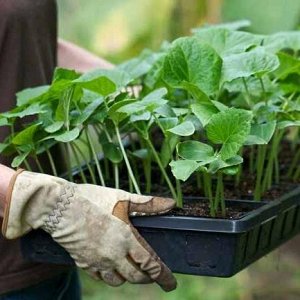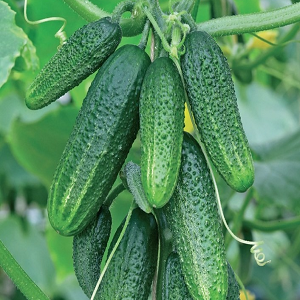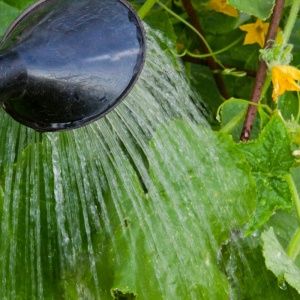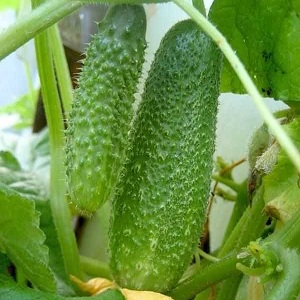Early ripe hybrid of cucumbers "Connie f1", resistant to weather conditions and diseases
Connie f1 cucumber appeared on the market in the late 90s of the twentieth century, and since then has remained one of the most popular hybrids of domestic selection. The culture is not inferior to the Dutch "brothers" either in productivity or in taste. With relatively low labor costs, you can get a rich harvest when grown in open and closed ground.
The gherkin type fruits are equally good fresh and canned. Like other parthenocarpics, the plant does not need bee pollination due to the female type of flowering. In this article, we will talk about the advantages and disadvantages of a hybrid, the nuances of cultivation and methods of protection against diseases and pests.
The content of the article
Description of the hybrid
Connie's first-generation hybrid is a product of the selective work of domestic biologists. The crop is suitable for growing in a greenhouse and vegetable garden in the spring-summer turnover.
Originator - St. Petersburg regional public organization "Union of Seed Producers" Association Biotechnics.
Bushes are indeterminate, vigorous, medium-growing, medium-leafy. The type of ovary formation is bunch. The fruits are of the same size, are not prone to overgrowth, do not turn yellow, and retain their presentation for a long time.
In the photo - Connie's cucumbers.

Distinctive features are presented in the table.
| Indicators | Characteristic |
| Ripening period | 47-50 days |
| Pollination type | Parthenocarpic |
| Weight | 60-82 g |
| Length | 7-9 cm |
| The form | Cylindrical, rounded in cross section |
| Coloration | Green |
| Leaves | Medium, green, wrinkled |
| Pulp | Dense, crispy |
| Taste | Refreshing without bitterness |
| Skin | Thin, with frequent small tubercles and white pubescence |
| Appointment | Universal |
| Yield | 13-16 kg / m² |
| Sustainability | To powdery mildew and root rot |
| Transportability | High |
Composition, calorie content and useful properties
The calorie content of cucumbers is only 14 kcal per 100 g.
Chemical composition of the product:
- vitamins A, B1, B2, B4, B5, B6, B9, C, E, H, K, PP and beta-carotene;
- minerals: potassium, calcium, silicon, magnesium, sodium, phosphorus, iron, iodine, copper, selenium, fluorine, zinc.
Regular consumption of cucumbers has a positive effect on the body:
- normalizes water-salt balance;
- accelerates metabolism;
- dilates blood vessels;
- normalizes blood pressure;
- breaks down cholesterol plaques;
- dissolves stones and sand in the kidneys;
- normalizes the work of the pancreas;
- improves blood counts.
Hybrid agricultural technology

Growing Connie's cucumber does not require special knowledge and skills. The main thing is to correctly determine the timing of planting or sowing seeds, to water, loosen and weed the beds in a timely manner, to feed them with organic matter and mineral complexes.
To obtain the maximum yield and prolong fruiting, the bushes are molded.
Seed planting
The seed is subjected to additional processing before sowing in the ground. The seeds are soaked in warm melt water with the addition of potassium permanganate for 30 minutes, then washed with water and spread on a damp cotton cloth. After 2-3 days, the seeds will germinate at an air temperature of +25 ° C.
Reference. To stimulate growth, the material is soaked in preparations "Zircon" or "Epin".
Direct sowing in the ground is carried out in the I-II decade of June, depending on the region of cultivation. The air temperature should not be lower than +22 ° С, the soil temperature +16 ° С.The soil is prepared in autumn: they dig up, add 10 liters of humus per 1 m², in the spring they loosen and fertilize with chicken droppings mixed with ash.
Seeds are laid with the pointed part down, to a depth of 2-3 cm, at a distance of 20 cm. The beds are watered with warm, settled water and covered with agrofibre to protect them from night frosts.
Seedling planting
The prepared grains are sown in 500 ml peat pots filled with a moist substrate. Prepare it yourself on the basis of two parts of peat and humus, one part of sawdust or river sand. For enrichment with minerals, add 25 g of superphosphate and a glass of ash to a bucket of mixture.
The containers are covered with plastic wrap to create a greenhouse effect and placed in a dark place. After the sprouts appear, the pots are taken out to a sunny place without drafts. With a lack of light, the seedlings are supplemented with phytolamps.
At the stage of the first leaves, the seedlings are fed with the preparation "Speedfol Amino Start". Use warm clean water for irrigation. Watering frequency - 1 time in 7-10 days.
The appearance of four true leaves and a healthy appearance of the seedlings indicate that you can start planting in a permanent place. Seedlings are planted in the greenhouse at the end of May, in open ground - in the first decade of June.
On the site, pits are formed with a depth of 15-20 cm. Each is spilled with a hot solution of potassium permanganate and 1 tbsp is added. l. superphosphate. Planting scheme - 50x70 cm, three bushes per 1 m².
Care
Hybrid care rules:
- At first, the plantings are covered with agrofibre to protect against a sharp drop in temperature at night.

- For irrigation, use warm rain or settled water. After planting, moderate watering is provided - once a week, during flowering and fruiting, the frequency is increased to three times a week. Watering is carried out in the evening strictly under the bush. Installing a drip irrigation system will help simplify the task.
- The beds are regularly loosened and weeded. Weeds are removed by the root. The top layer of soil is mulched with straw, hay or sawdust to retain moisture, prevent the growth of weeds, and provide additional nutrition.
- Before flowering, root dressing is carried out - once every 14 days with ready-made mineral or organic compounds ("Yara Mila complex", "Ovary", "Bud", "Fertility").
- From the moment the flowers appear until the end of the harvest, foliar dressing is carried out with "Plantafol", "Agricolo", "Fertika".
Here are examples of root dressings for cucumbers that are prepared independently:
- three-day infusion of nettle or tops, diluted with water in a 1: 5 ratio;
- infusion of poultry or quail droppings diluted with water 1:20;
- 200 g ash / 10 l water, shake and pour;
- 50 g of fresh yeast, pour 3 liters of warm water, add 50 g of sugar, leave in a warm place for 5-6 hours;
- 30 g nitroammophoska / 10 l water.
Reference. The consumption rate of fertilizing for young plants is 0.5 ml, for adults - 1-2 liters. A week after adding ash, the cucumbers are fed with nitrogen or chicken droppings.
Features of cultivation and possible difficulties
When cultivating a Connie hybrid in a greenhouse, it is important to control the temperature and humidity. In the heat, the vents and doors are kept constantly open or the outer walls are irrigated with a weak solution of chalk to shade the room. The drips will create diffused light, reducing the illumination.
The air humidity in the greenhouse should be 85-90%. To maintain it, regular watering and spraying of plantings is carried out.
When growing Connie in a greenhouse, you can influence the speed of plant development by increasing the concentration of carbon dioxide in the air. For this, a barrel with a manure solution is installed in the room - carbon dioxide is released during its fermentation.
In the open ground, to protect from the scorching sun, special nets are used or, at the same time as planting cucumbers, they sow curtain plants (sunflower, corn). They create shade and protect against drafts.

Connie's parthenocarpic needs to be properly shaped and tied to the trellis:
- Shoots, flowers and ovaries are removed in the axils of the first five leaves. They inhibit the growth of the main stem.
- The main lash is tied to the trellis as it grows.
- The stepsons pinch over the second leaf to the height of the whip 0.5 m, over the third - up to 1 m, over the fourth - up to 1.5 m, over the fifth - up to 2 m.
- The lash is pinched at the level of the extreme point of the trellis or thrown over the crossbar and pinched 1 m from the ground.
Diseases and pests
Connie's cucumber is resistant to powdery mildew and root rot. The plant suffers from anthracnose (copperhead), sclerotinia, bacteriosis and is susceptible to insect attacks (aphids, spider mites, whiteflies, cucumber bugs). A detailed analysis of the signs of infection and methods of treatment is in the table.
| Disease / pest | Signs | Treatment |
| Anthracnose | Yellow spots on the face of leaves at the onset of the disease, brown spots in the acute phase, dryness of leaves and stems.
|
Treatment with a 1% solution of Bordeaux liquid, infusion of wood ash (300 g per 10 l), soapy solution (50 g of shavings per 10 l of water). Spraying the bushes is carried out once a week.
|
| Bacteriosis | Angular yellow-brown spots on cotyledon leaves, mucus on the back of the leaves. | 100 g of onion peel per 1 liter of boiling water. After two days, strain and dilute with water 1: 5. Process the bushes in the evening, once every 10 days.
|
| Cucumber bug | Curling and dying off of leaves, spots and holes from bites. | 200 tobacco shag / 5 liters of water. After two days, strain and add 5 liters of water. Treatment frequency is twice a week. |
| Spider mite | Small white dots on the back of the leaves, thin cobwebs that twine around the bushes. | 30 g finely chopped hot peppers / 10 l of water. After a day, spray the bushes once. |
| Aphid | Drooping leaves, drops of honeydew, a large concentration of ants. | 30 g of dry dandelion roots and foliage / 1 l, leave for three hours. Spray twice a week apart. |
| Whitefly | Sticky bloom on stems and leaves, many white larvae at an early stage and schools of white moths at a later stage. | 500 g of dry herb yarrow / 5 l of water. After two days, strain and process the bushes twice, after 7 days. |
Disease prevention:
- processing greenhouses with sulfur checkers;
- disinfection of soil with copper sulfate;
- pre-sowing seed treatment in "Fitosporin" or potassium permanganate;
- frequent loosening and weeding of beds;
- removal of plant residues.
Harvesting and application of the crop
The first fruits are harvested approximately 45 days after planting. If you plant seedlings at the end of April, then the first cucumbers will appear in the second decade of June.
The culture is characterized by a prolonged fruiting period, which allows you to enjoy the excellent taste of cucumbers before the onset of cold weather. In the refrigerator, fruits are stored for no more than five days. To preserve the harvest longer, it is recommended not to wash off the natural plaque and not to tear off the stalk. In this form, the greens are stored in the cellar for about a month.
Cucumbers are used for preparing fresh vegetable salads, slicing, pickling and pickling for the winter.
Advantages and disadvantages
Advantages:
- early maturity;
- short-term fertility;
- resistance to powdery mildew and rot;
- long fruiting period;
- excellent taste without bitterness and firm flesh;
- transportability.
Disadvantages - the need to shape the bush, susceptibility to bacteriosis and anthracnose.
Reviews
Reviews of Connie's hybrid are positive. Gardeners note a high percentage of seed germination, productivity and excellent taste.
Irina, Tyumen: “I have been growing Connie's cucumbers for a long time, it is easy to care for the bushes, the main thing is to form them correctly and feed them on time. Cucumbers are all smooth, as if on a selection, sweet, crunchy without bitterness. We roll it up for the winter in marinade and brine. "
Nikolay, Yaroslavl: “Planting and caring for Connie's hybrid is not difficult, even for beginners. I prefer to soak seeds in "Epin" before sowing for seedlings. Zelentsy are dark green, with small, thornless pimples.The taste is excellent, without bitterness. Cucumbers in jars do not get wet. "
Vera, Moscow: “Among the many hybrids and varieties of cucumbers, I chose Connie five years ago on the recommendation of a store seller and did not regret it. Cucumbers are small, like gherkins, do not outgrow. The skin is thin, pimply. The bushes are powerful, tall and rarely get sick with proper care. "
Conclusion
Connie's hybrid is a great option for those who value high productivity and ease of maintenance. The culture is not demanding on the composition of the soil and growing conditions, it gives the same result when grown in a greenhouse and in a vegetable garden. Cucumbers are the same size, do not outgrow, voids do not form inside the fruit. The pulp is juicy, slightly sweet, without bitterness.
Tall bushes are formed according to the rules corresponding to the parthenocarpic culture, with a garter to the supports. In the heat, the plant is shaded from the scorching sun and the frequency of watering is increased. Organic and mineral compounds are used for feeding.